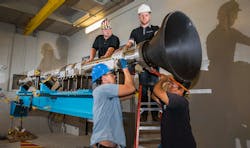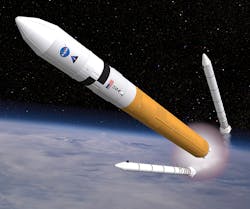Shock-Wave Testing on Space Rockets Goes “Green”
When a rocket goes into the extremes of our atmosphere, the rocket experiences an aggressive shock at separation stage, which could knock out the system’s avionics. Testing these avionics to ensure they can withstand the shock is one the most crucial pre-flight tests conducted.
During the separation of a rocket, avionics systems experience a large shock wave, causing strain on the equipment. Using the pyroshock test, engineers are able to analyze how the equipment can withstand the strain of the separation.
In the past, the avionics underwent a pyroshock test. The typical pyroshock test uses explosives encased in lead to provide the different impacts that parts would experience during flight. The lead and explosives are, of course, environmental hazards, resulting in a costly and time-consuming cleanup process. Engineers at the Sandia National Laboratories wanted to improve the process. Managed and operated by the National Technology and Engineering Solutions of Sandia, the Sandia National Laboratories represents one of the three National Nuclear Security Administration research and development labs.
New Test Worth a “Shot”
The team of engineers at the Sandia Labs developed a new method that uses a nitrogen-powered gas gun to create the necessary impact. The test is being called the Alternative Pyroshock Test (APT). Team mechanical engineer Mark Pilcher talks about how the team recognized the need to create a less-destructive testing alternative.
“We recognized early in the program that we need to seek out alternative test methods in order to reduce our hazardous work exposure, minimize environmental waste, and develop a controlled and repeatable test capability,” says Pilcher. “Investigating a large-scale, nonexplosive gas gun test became a reality when we partnered with Sandia’s large-scale mechanical test facilities. The combined team worked hard to get to this test.”
Engineers at the Sandia National Laboratories prepare a nitrogen-powered gas gun for the Alternative Pyroshock Test by installing a resonant cone to a resonant beam. The new testing method will create a more environmentally friendly way to ensure avionics can withstand the shock from stage separation during flight.
The APT uses the nitrogen-powered gas gun to shoot a 100-lb. steel projectile into a steel resonant beam. This transfers energy through a resonant cone attached to the part of the aircraft being tested, which mimics the conditions of stage separation in space. The first test of this type using the flight hardware was completed this past spring. Initial investigations into test alternatives led them to using a Hopkinson bar.
Hopkinson (Kolsky) Bar Approach
Bertram Hopkinson first suggested the Hopkinson pressure bar in 1914 as a method of measuring stress pulse propagation in a metal bar. Later, H. Kolsky refined the technique by using two bars in series. A specimen is placed between the ends of two straight bars, called the incident and transmitted bars, and a stress wave is applied a significant distance away from the test specimen. The stress wave splits into to two smaller waves upon reaching the specimen. The transmitted wave travels through the specimen and into the transmitted bar, causing plastic deformation. The other reflected wave is reflected away from the specimen and travels back down the incident bar. By using the Hopkinson technology and running small-scale tests, the team could provide the frequency levels and mechanical energy needed to recreate large-scale test conditions.
The team conducted more than 50 tests to determine the exiting velocity for the gas gun; how to design a Hopkinson bar-type apparatus at a larger scale; design a steel resonant cone to transfer the energy; and how to manipulate the pulses of energy using small copper coins called programmers or pulse shapers. These pulse shapers are placed on the surface of the resonant bar. According to team engineer Bo Sung, the pulse shapers were the most difficult part due to selecting the right material, geometry, and dimensions.
A 100-lb. solid-steel projectile, fired from a 6-in. gas gun, impacts the material of a resonant bar attached to a test article. The impact initiates a wave that travels through the resonant bar assembly into the test article, simulating a stage-separation pyroshock event.
The nitrogen gas gun used for the APT is 60 feet long and fires the metal projectiles into a resonant beam coupled with a resonant cone to expand the final diameter to interface with the rocket. This is Sandia’s large-scale hybrid version of the Hopkinson bar technique. The resonant beam is 1,500 lbs. and slightly over 8 feet long. The resonant bar and cone vibrate at the correct frequencies to apply the right amount of energy for testing.
The future looks promising as the success of Sandia’s APTs can be applied to other research areas. Future tests will require less development and setup, and provide significant cost savings. According to Sung, “[t]he same concept can be used for a variety of defense and space applications. This provides a new path for pyroshock testing, but very clean and more controllable and will save a lot of costs.”



